The Internet has changed everything from the way we consume news to the way we buy stuff to way we interact with one another. It has also changed the way we elect our political candidates. Presidential and Congressional campaigns are now hiring digital gurus and spending millions on data mining and advertising.
But here’s the thing: The Internet can be the Great Equalizer. If you understand the rules and know some of the tricks, you can get big results for small dollars.
You have a lot of moving parts to manage in a political campaign. Like most things in business and everyday life, there are inventions for every necessity. In the Internet age, there’s no shortage of technologies available to help with any challenge. But the chances are you’re not an expert in any of those areas, let alone all of them!
Which technology is best? How to do you get them to work together?
Each campaign need has multiple solutions. That means there are dozens, maybe hundreds, of different combinations that can do the job. A “technology stack” is a collection of technologies that work together. In this post, we’ll share our recommended technology stack and explain the components.
Our technology stack presents a (more or less) complete digital solution for most small to medium campaigns. You don’t need to implement everything in this stack and you can substitute in most instances.
Let’s walk through these components one at a time. These are presented in relative order of importance.
Website
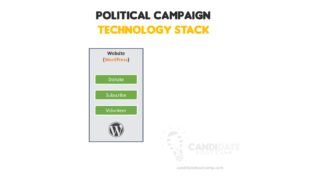 We’re going to sound like a broken record: Every candidate should have a website. It’s inexpensive and not terribly difficult to do yourself. Some of the benefits include:
We’re going to sound like a broken record: Every candidate should have a website. It’s inexpensive and not terribly difficult to do yourself. Some of the benefits include:
- Visibility: Getting on the world wide web will give you much more visibility than just a Facebook page, for example.
- Ownership: You will own your website and all of its content. Forever.
- Functionality: As your campaign grows, your website can grow with it and support more and more features.
WordPress (www.wordpress.org) is a free technology that has become – by far – the most widely used website platform on the Internet. There are thousands of “themes” available that determine the layout, look, and feel of your site. There are thousands of “plugins” that are software programs you can easily add on to your website to provide additional functionality. Some of the more important actions your website should support include:
- Donate: Visitors to your website should be both inspired and encouraged to donate to your campaign. It must be prominent, fast, and easy to make a donation!
- Subscribe: Next to donations, a high-quality email database is the most valuable asset your campaign will have. Your website should offer an easy way for supporters to opt into your email list.
- Volunteer: If people are willing to donate time or put a sign in their yard, again, you’ll want to make it quick and painless for them to express that interest.
Donations
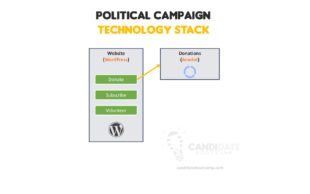 Your campaign will have a difficult time reaching voters without spending money for advertising, infrastructure, and in some cases staff. You’ll need donations to fund those activities and if it isn’t extremely simple, easy, and safe to give you money, you’ll be losing valuable donations.
Your campaign will have a difficult time reaching voters without spending money for advertising, infrastructure, and in some cases staff. You’ll need donations to fund those activities and if it isn’t extremely simple, easy, and safe to give you money, you’ll be losing valuable donations.
Using a third-party solution removed several headaches you’d otherwise be forced to deal with.
- Credit Card Processing: Many donations are impulse decisions and you need to make the transaction quickly before the urge disappears.
- Online: These online services allow supporters to donate on their website and/or easily embed donation forms on your own website.
- Reporting: Depending upon your campaign size, you may be required to file reports with your state and/or the FEC. These services quickly and easily generate those reports for you.
Anedot (anedot.com) is one of the solutions we recommend among a large field of competitors. They offer solid functionality at a reasonable price. There are no monthly fees, just a transaction fee plus a percentage of the donation. You’ll easily make up that cost with more donations and time saved. It’s also very easy to embed a donation form on your WordPress website and have those donations processed in Anedot.
Contact Database
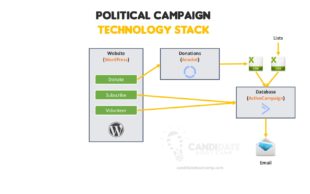 A strong campaign database is one of those secret weapons that can catapult a campaign to success. Many small campaigns rely on spreadsheets, which is quick and easy but prone to all sorts of problems. We recommend an online database that also serves as your email engine.
A strong campaign database is one of those secret weapons that can catapult a campaign to success. Many small campaigns rely on spreadsheets, which is quick and easy but prone to all sorts of problems. We recommend an online database that also serves as your email engine.
ActiveCampaign (www.activecampaign.com) is a powerful yet inexpensive tool that can serve as your volunteer database, donor database, and email marketing system. It’s all wrapped into one, easy-to-use solution that is cloud-based and allows up to three separate users to access the account. It’s ideal for political campaigns and starts at just $9 per month.
Other inexpensive email marketing tools include Mailchimp, Constant Contact, AWeber, Freshmail, etc. Some email solutions (e.g. Mailchimp) offer a free version. While we’re big fans of Mailchimp, we think that the $9 per month for ActiveCampaign is more than worth the powerful features you’ll be able to use.
Your website’s subscribe and volunteer forms should automatically flow through to your database. This is easy to set up in WordPress. Ideally, your donations should as well. As of this version of this ebook, there are no recommended donation services that offer this level of integration, though Anedot is currently working on it.
Instead, you’ll need to periodically export the donations and import them into your database, whether it’s ActiveCampaign, Mailchimp, or any other email program. You can also import other lists, such as your own personal supporter list, voter lists you may acquire, and any others you obtain.
Social Media
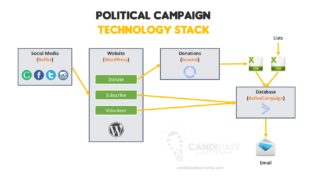 I think by now all candidates understand the power of social media for their campaigns. But which channels should you use? And how should you use them? We’ll talk in more detail about this in a future chapter. However, we do want to mention another tool in our stack that we think can help organize your social media presence.
I think by now all candidates understand the power of social media for their campaigns. But which channels should you use? And how should you use them? We’ll talk in more detail about this in a future chapter. However, we do want to mention another tool in our stack that we think can help organize your social media presence.
Some of the challenges with social media include:
- You’re likely active on more than one platform, so how do you share the same content efficiently?
- The times when you are online and posting content may not be the best times in terms of your audience presence. How do you address that?
- If you have a campaign calendar, how to you ensure that notifications and reminders go out at precisely the right times?
There’s a free tool called Buffer (buffer.com) that does a wonderful job solving all three of those problems. With the free version, you can connect up to 10 social networks, automatically and/or manually posts to publish at optimal times, easily create high-quality graphics to go along with your posts, and include link-shortening and tracking.
Buffer works by establishing pre-defined publishing windows for each social network. The best time to publish to your Facebook audience may be different than Twitter, which may be different from Instagram, which may be different from LinkedIn. And the posting frequency on those networks is different as well. Buffer allows you to quickly and easily share a single post to multiple networks at the ideal times.
Analytics
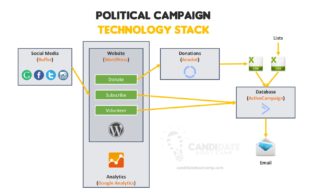 Once you have a website running and are working on social media, it’s important to understand how much traffic your website is seeing and where it’s coming from. Google Analytics (www.google.com/analytics) is a very powerful, free tool that will monitor this traffic and give you the insights you need to adjust your digital strategies accordingly. It’s very easy to integrate with your website and since it’s free, why not take advantage?
Once you have a website running and are working on social media, it’s important to understand how much traffic your website is seeing and where it’s coming from. Google Analytics (www.google.com/analytics) is a very powerful, free tool that will monitor this traffic and give you the insights you need to adjust your digital strategies accordingly. It’s very easy to integrate with your website and since it’s free, why not take advantage?
If you plan on using Facebook extensively, we also highly recommend installing the Facebook tracking pixel. It’s similar to Google Analytics but it provides a much richer demographic profile of your visitors. It’s also free (you need to have a Facebook Page for this to be available).
Advertising
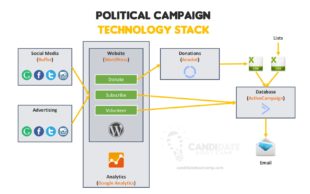 The great thing about digital advertising is that it’s easy for the novice to use! The bad thing about digital advertising is that it’s easy for the novice to use! What does that mean? It means that while it’s very simple for anyone to boost a post on Facebook or create Google AdWords campaign, it’s difficult to get great results.
The great thing about digital advertising is that it’s easy for the novice to use! The bad thing about digital advertising is that it’s easy for the novice to use! What does that mean? It means that while it’s very simple for anyone to boost a post on Facebook or create Google AdWords campaign, it’s difficult to get great results.
That’s one of the reasons why our technology stack prioritizes analytics over advertising. If you don’t have the resources to implement decent online analytics, you shouldn’t be wasting your money with digital advertising because you’ll be flying completely blind. You’ll have no idea what’s working and what isn’t.
Digital advertising is a pretty big topic itself. We’ve written a whole ebook that will teach you how the basics plus a few insider tips and tricks.
Here’s the full campaign technology stack. Click on the image to view it full-sized.


